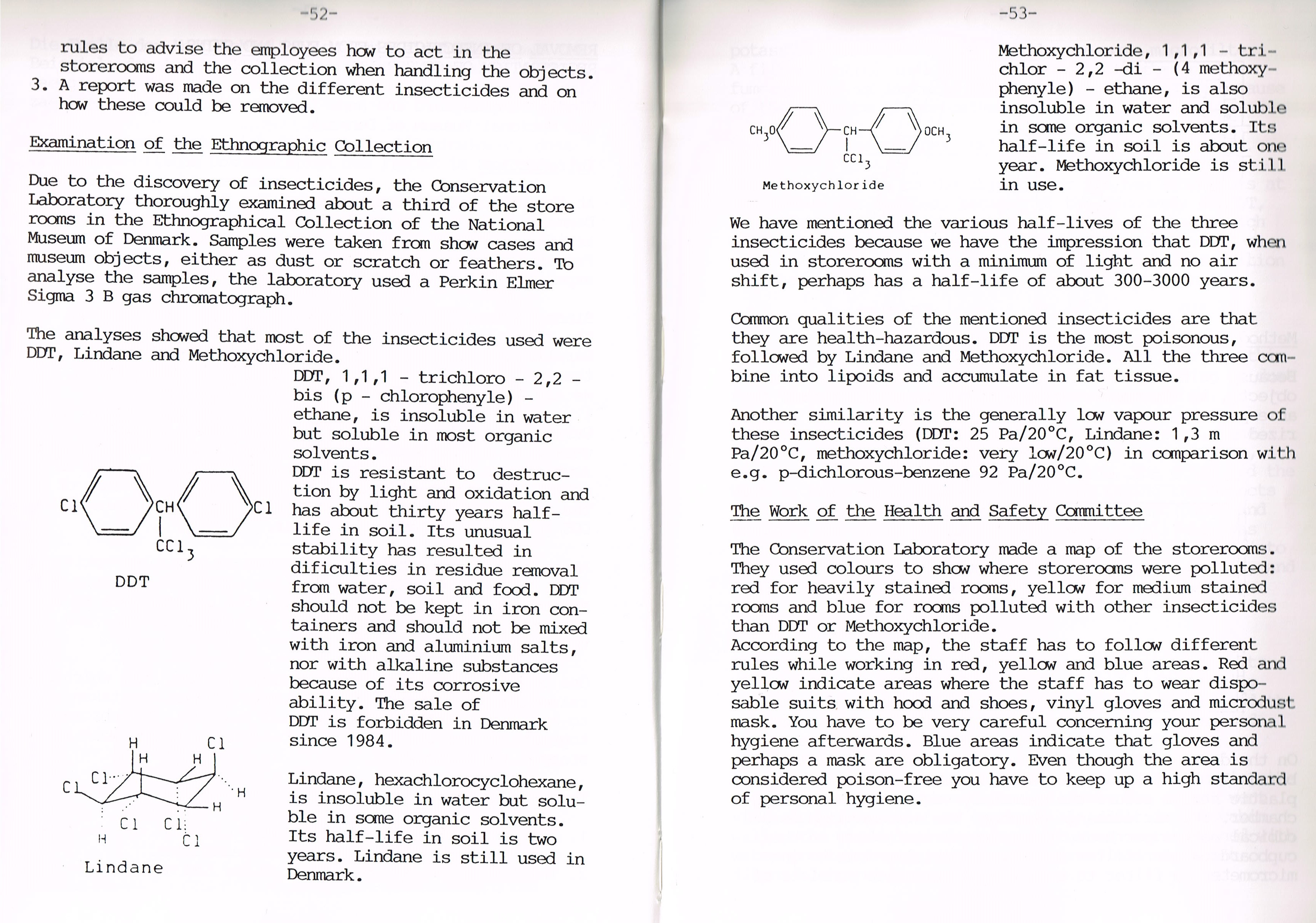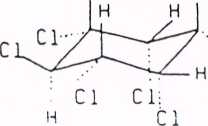CCI20140507�29

-52-
rules to advise the employees how to act in the storerooms and the collection when handling the objects. 3. A report was madę on the different insecticides and on how these could be removed.
Examination of the Ethnographic Collection
Due to the discovery of insecticides, the Conservation Laboratory thoroughly examined about a third of the storę rooms in the Ethnographical Collection of the National Museum of Denmark. Samples were taken from show cases and museum objects, either as dust or scratch or feathers. To analyse the samples, the laboratory used a Perkin Elmer Sigma 3 B gas chromatograph.
The analyses showed that most of the insecticides used were DDT, Lindane and Methoxychloride.
EOT, 1 ,1 ,1 - trichloro - 2,2 -bis (p - chlorophenyle) -ethane, is insoluble in water but soluble in most organie solvents.
c,OrO“
CC13
DDT
H Cl

Lindane
DDT is resistant to destruc-tion by light and oxidation and has about thirty years half-life in soil. Its unusual stability has resulted in dificulties in residue removal frcm water, soil and food. DDT should not be kept in iron con-tainers and should not be mixed with iron and aluminium salts, nor with alkaline substances because of its corrosive ability. The sale of DDT is forbidden in Denmark sińce 1984.
Lindane, hexachlorocyclohexane, is insoluble in water but soluble in some organie solvents. Its half-life in soil is two years. Lindane is still used in Denmark.
Methoxychloride, 1,1 ,1 - tri-chlor -2,2 -di - (4 methoxy -phenyle) - ethane, is also insoluble in water and soluble in some organie solvents. Its half-life in soil is about one year. Methoxychloride is still in use.

OCH,
Methoxychlor ide
We have mentioned the various half-lives of the three insecticides because we have the impression that DDT, when used in storerooms with a minimum of light and no air shift, perhaps has a half-life of about 300-3000 years.
Common ąualities of the mentioned insecticides are that they are health-hazardous. DDT is the most poisonous, followed by Lindane and Methoxychloride. A11 the three ccm-bine into lipoids and accumulate in fat tissue.
Another similarity is the generally lew vapour pressure of these insecticides (DDT: 25 Pa/20°C, Lindane: 1,3 m Pa/20°C, methoxychloride: very lcw/20°C) in comparison with e.g. p-dichlorous-benzene 92 Pa/20°C.
The Work of the Health and Safety Committee
The Conservation Laboratory madę a map of the storerooms. They used colours to show where storerooms were polluted: red for heavily stained rooms, yellow for medium stained rooms and blue for rooms polluted with other insecticides than DDT or Methoxychloride.
According to the map, the staff has to follcw different rules while working in red, yellcw and blue areas. Red and yellcw indicate areas where the staff has to wear dispo-sable suits with hood and shoes, vinyl gloves and microdust mask. You have to be very careful conceming your persona 1 hygiene afterwards. Blue areas indicate that gloves and perhaps a mask are obligatory. Even though the area is considered poison-free you have to keep up a high standard of personal hygiene.
Wyszukiwarka
Podobne podstrony:
of Conscious Intention to Act in Relation to Onset of Cerebral Activity (Readiness-Potential): The U
17fg002 User clicks around Employee Hessagę from window to window in a non-linear and unpr
As the blood thatflows through our bodies is staunched, goes back to the earth, so I bind
jow03 07 Ttm. Poaitton (a) ainfc łnto Pooitlon (b)* Allow thc body to alnk in o atralght lino, and n
u ultra vires - beyond powers - to act in a way which exceeds your legał powers unanimous - used to
anatomia?bka Female Anatomy Patterns Pattern Grid over Female Anatomy. To assist in remembering plac
2 13 How to succeed in negotiation? The negotiations are a long-term process and do not begin with s
130 Agata Borowska-Pietrzak surveys can sensitize the area of HRM to changes in employee preferences
SIDEWALK ( Start Vabdatir>g ) [ How to Labet ) [ Help ] Sgnm f ind and tabel the (oacrAinj40 Scun
52 (333) 3.5.4A. Non-specific technique for the super-ficial ventral muscles to increase dorsal flex
When and how to enrol To enrol in UHIP® you may contact the university and register for UHIP® before
Truth table We can use the above rules to find the truth tables of morę complex compound statements.
Text A 1 How big are the groups at the Beginners Filmmaking Club? 2 What do they l
how to wear?rk green wear dark green http://www.trinnyandsusannah.com/rules/darkgrecnHOW TO WEAR DAR
c114c00804611866cbeb30e821a1811d Rules to New Girl’s True American Gamę prep: Arrange the cans of be
więcej podobnych podstron